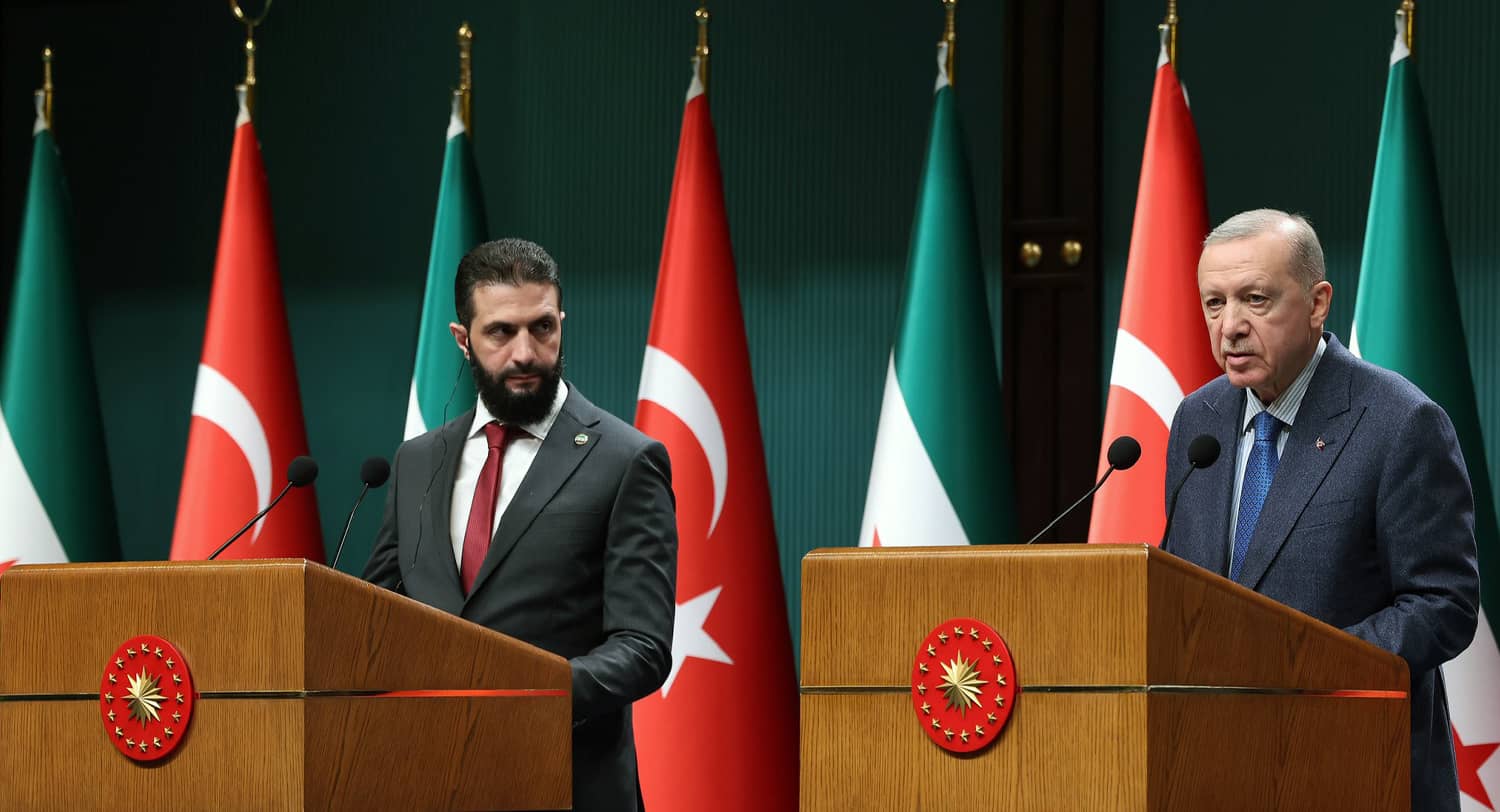When Bashar al-Asad’s regime abruptly collapsed in December 2024, Turkish President Recep Tayyip Erdoğan saw more than just a regional upheaval. He saw a long-awaited opportunity.
With Iran’s influence waning and Russia distracted by internal instability and foreign entanglements, a rare power vacuum emerged in Syria. Erdoğan moved swiftly. For over a decade, Ankara had supported Hayat Tahrir al-Sham (HTS), the al-Qa’ida offshoot that ultimately toppled Asad’s regime, under the leadership of Muhammad al-Jolani (who would drop this nom de guerre in 2025 and re-assume his birth name, Ahmed al-Shara’a). HTS was just one of several Sunni Islamist factions that Turkey had backed since the earliest days of Syria’s civil war, beginning in 2011.
For Erdoğan, the war in Syria was never simply about toppling a brutal dictatorship. It was a generational chance to reshape the Middle East, fulfilling a vision rooted in establishing a neo-Ottoman regional order with Turkey at its helm.
Beginning in 2012, Ankara openly aligned itself with the Syrian opposition, betting that Asad’s days were numbered, much like the authoritarian regimes that had fallen in Egypt, Libya, and Tunisia during the Arab Spring. Erdoğan miscalculated. Asad endured, thanks to backing from Tehran and Moscow.
It would take another twelve years for Erdoğan’s vision to find traction. By March 2025, a new interim government led by Ahmed al-Shara’a had taken charge in Damascus. This political outcome was the culmination of Turkey’s long-standing efforts to influence Syria’s post-Asad trajectory. And yet, this strategy marked a profound evolution in Erdoğan’s approach to Damascus. Before the civil war, between 2004 and 2011, he had in fact pursued a pragmatic detente with Asad, signaling a very different strategic calculus.
The notion that Erdoğan and Asad once embraced as allies may now seem surreal, but it reflects a brief window of diplomatic realignment. To understand that moment, one must consider the deeper ideological fault lines that have long defined Turkish-Syrian relations.
Turkey’s hostility toward the Asad regime predates Erdoğan. Ideologically, it is rooted in the worldview of the National View Movement, the Turkish Islamist tradition from which Erdoğan’s Justice and Development Party (AKP) arose. Since the rule of Hafiz al-Asad (1971–2000), these Turkish Sunni Islamists regarded Syria’s Alawite-dominated Ba’athist regime with suspicion and disdain, as secular socialists who were dangerously close to the Soviet Union. They supported the Syrian Muslim Brotherhood, especially after the Ba’athists banned the group in 1964.
Among the most vocal critics of the Syrian Ba’ath was Necmettin Erbakan, founder of the Islamist Welfare Party and Erdoğan’s political mentor. Erbakan deeply resented the Ba’athist crackdown on Sunni Islamist forces and privately cheered the Brotherhood’s calls for jihad against Damascus. Although he refrained from open confrontation with the Syrian state, Erbakan’s ideological hostility was clear. Following this line, Erdoğan and his foreign policy architect Ahmet Davutoğlu, saw the Asad regime as secular tyrants and, in the words of one Turkish analyst, as “illegitimate elites of a minority sect that had done more damage to Islam as a religion than had the West.”
That historical resentment fueled Turkey’s antagonistic posture during the Cold War, when Ankara and Damascus frequently found themselves on opposite sides of geopolitical and ideological divides. Most explosively, Syria served as a patron for the Kurdistan Workers’ Party (PKK), offering sanctuary to its leader, Abdullah Ocalan, and providing logistical support for the group’s separatist campaign inside Turkey. The PKK’s operations from Syrian soil brought the two countries to the brink of war in 1998, a confrontation only defused when Damascus expelled Ocalan under Turkish pressure. As a result, it is worth pointing out that Turkish elites’ suspicion of Syria was not limited only to the Islamist camp: it was shared across Turkey’s political spectrum.
Yet when Erdoğan assumed office as prime minister in 2003, he temporarily shelved those long-standing grievances in favor of a pragmatic reorientation. Early in his tenure, Erdoğan cultivated a reputation in Western capitals as a capable leader willing to sideline ideology for realpolitik. This image was embodied in the “zero problems with neighbors” doctrine, a cornerstone of Davutoğlu’s foreign policy vision. Its aim was to normalize relations with regional adversaries, including Syria.
Erdoğan’s pivot toward Damascus was also driven by his deepening disillusionment with Europe. After the European Union effectively stalled Turkey’s accession process in 2007, Ankara’s foreign policy began to shift decisively toward the Middle East. The 2008 global financial crisis further weakened Turkey’s economic alignment with Europe, accelerating Erdoğan’s pursuit of new trade and political alliances in the Arab world, with Syria at the center of this new orientation.
Between 2004 and 2010, bilateral relations between Turkey and Syria improved dramatically. The two countries formed a high-level Strategic Cooperation Council and signed a series of free trade and visa liberalization agreements. Trade volume more than doubled — from $800 million in 2003 to $1.8 billion in 2010. Syrian tourists flocked to Turkish cities such as Gaziantep, spurring local economic booms and the construction of shopping malls tailored to Syrian consumers. For a brief moment, Syria served as a critical land bridge for Turkish truckers bringing goods to Jordan and the Gulf, an economic artery that gave substance to the improving relations.
The warm rapport between Erdoğan and the Asad family during this period led some observers to question whether ideologically committed Islamist leaders like Erdoğan could, in fact, evolve into pragmatic statesmen once in power. Until 2012, there was reason to believe that Erdoğan might subordinate ideology to the imperatives of national interest.
So, what changed?
The answer lies not only in the outbreak of the Syrian civil war, but in Erdoğan’s strategic recalibration. By 2011, the Arab Spring had dramatically altered the political landscape across the region. Erdoğan, emboldened by the downfall of Arab autocrats, assumed Asad’s regime would follow suit. His support for oppositionist forces, including jihadist groups like HTS, was less about democracy and more about engineering a Sunni realignment in Syria that would align with Ankara’s regional ambitions.
The Syrian war became, for Erdoğan, both a proxy conflict and a proving ground for a new Turkish sphere of influence. The fall of Asad in 2024 vindicated a long and risky bet. The rise of Ahmed al-Shara’a, a former jihadist handpicked and mentored by Ankara, now in power in Damascus, signals the culmination of a strategy that began not with the first shots of civil war, but with decades of ideological suspicion and a fairly brief, ill-fated experiment in pragmatism.
In the end, Erdoğan preferred a Syria that would be closely aligned with his Islamist worldview, rather than one that was merely aligned with Turkey’s national interests. He would spend over a decade attempting to overthrow Asad in pursuit of this goal. Since the founding of Turkey as a republic in 1923, no Turkish leader had ever engaged in a process of regime change in a foreign country. Erdoğan would defy this trend. When Asad eventually fell, Erdoğan did not merely react to Syria’s collapse. He had prepared for it, waited for it, and helped shape it.
This is Part I of a series of reports by Sinan Ciddi on Turkey’s role in Syria.

